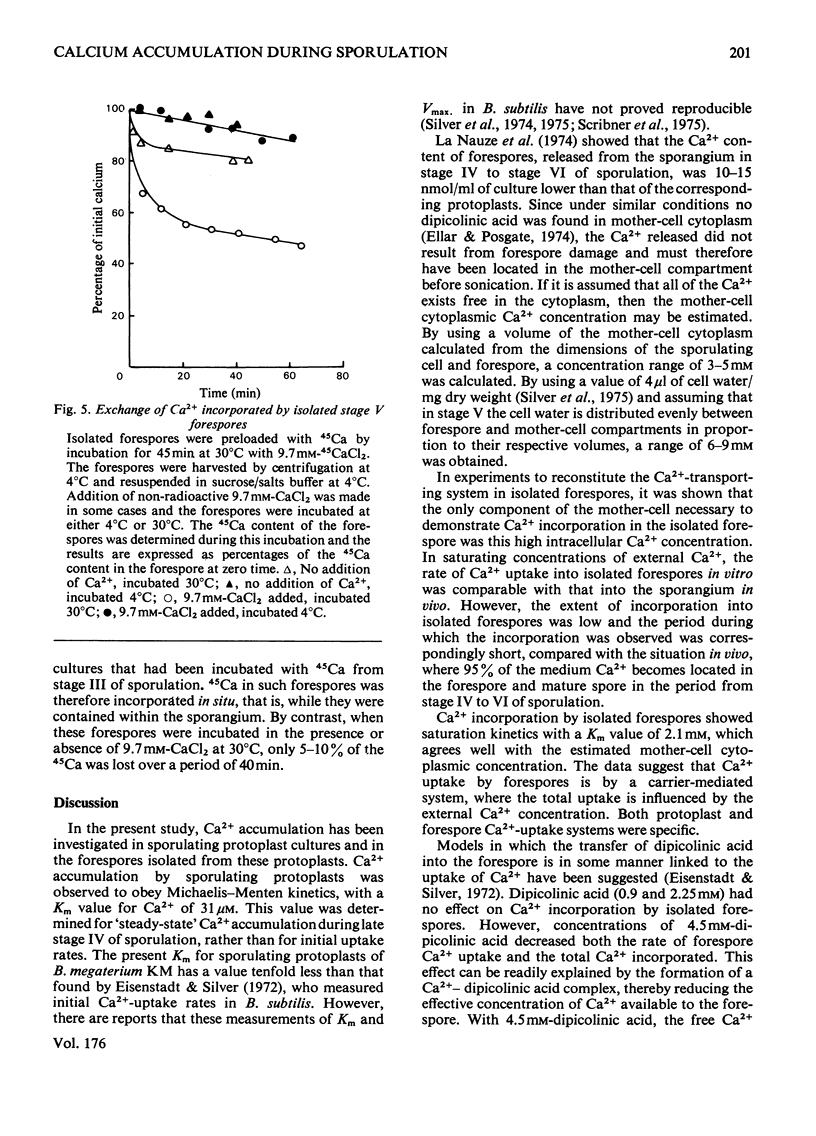Abstract
Accumulation of Ca2+ in Bacilli occurs during stages IV to VI of sporulation. Ca2+ uptake into the sporangium was investigated in Bacillus megaterium KM in protoplasts prepared in stage III of sporulation and cultured to continue sporulation. These protoplasts and whole cells exhibit essentially identical Ca2+ uptake, which is compared with that of forespores isolated in stage V of sporulation. Ca2+, uptake into both sporangial protoplasts and isolated forespores occurs by Ca2+-specific carrier-mediated processes. However, protoplasts exhibit a Km value of 31 micrometer, and forespores have a Km value of 2.1 mM. Sporangial protoplasts accumulate Ca2+ against a concentration gradient. In contrast, Ca2+ uptake into isolated forespores is consistent with downhill transfer in which both rate and extent of uptake are affected by the external Ca2+ concontration. Dipicolinic acid has no effect on Ca2+ uptake by isolated forespores, apart from decreasing the external Ca2+ concentration by chelation. A model for sporulation-specific Ca2+ accumulation is proposed, in which Ca2+ is transported into the sporangium, resulting in a concentration of 3--9 mM in the mother-cell cytoplasm. This high concentration of Ca2+ enables carrier-mediated transfer down a concentration gradient into the forespore compartment, where a low free Ca2+ concentration is maintained by complexing with dipicolinic acid.
Full text
PDF






Selected References
These references are in PubMed. This may not be the complete list of references from this article.
- Andreoli A. J., Suehiro S., Sakiyama D., Takemoto J., Vivanco E., Lara J. C., Klute M. C. Release and recovery of forespores from Bacillus cereus. J Bacteriol. 1973 Sep;115(3):1159–1166. doi: 10.1128/jb.115.3.1159-1166.1973. [DOI] [PMC free article] [PubMed] [Google Scholar]
- Chasin L. A., Szulmajster J. Biosynthesis of dipicolinic acid in Bacillus subtilis. Biochem Biophys Res Commun. 1967 Dec 15;29(5):648–654. doi: 10.1016/0006-291x(67)90265-3. [DOI] [PubMed] [Google Scholar]
- Forman M., Aronson A. Regulation of dipicolinic acid biosynthesis in sporulating Bacillus cereus. Characterization of enzymic changes and analysis of mutants. Biochem J. 1972 Feb;126(3):503–513. doi: 10.1042/bj1260503. [DOI] [PMC free article] [PubMed] [Google Scholar]
- Freese E. Sporulation of bacilli, a model of cellular differentiation. Curr Top Dev Biol. 1972;7:85–124. doi: 10.1016/s0070-2153(08)60070-8. [DOI] [PubMed] [Google Scholar]
- Hanson R. S., Peterson J. A., Yousten A. A. Unique biochemical events in bacterial sporulation. Annu Rev Microbiol. 1970;24:53–90. doi: 10.1146/annurev.mi.24.100170.000413. [DOI] [PubMed] [Google Scholar]
- Hoganson D. A., Stahly D. P. Regulation of dihydrodipicolinate synthase during growth and sporulation of Bacillus cereus. J Bacteriol. 1975 Dec;124(3):1344–1350. doi: 10.1128/jb.124.3.1344-1350.1975. [DOI] [PMC free article] [PubMed] [Google Scholar]
- Leanz G., Gilvarg C. Dipicolinic acid location in intact spores of Bacillus megaterium. J Bacteriol. 1973 Apr;114(1):455–456. doi: 10.1128/jb.114.1.455-456.1973. [DOI] [PMC free article] [PubMed] [Google Scholar]
- Lusk J. E., Kennedy E. P. Magneisum transport in Escherichia coli. J Biol Chem. 1969 Mar 25;244(6):1653–1655. [PubMed] [Google Scholar]
- Rosen B. P., McClees J. S. Active transport of calcium in inverted membrane vesicles of Escherichia coli. Proc Natl Acad Sci U S A. 1974 Dec;71(12):5042–5046. doi: 10.1073/pnas.71.12.5042. [DOI] [PMC free article] [PubMed] [Google Scholar]
- Silver S. Active transport of magnesium in escherichia coli. Proc Natl Acad Sci U S A. 1969 Mar;62(3):764–771. doi: 10.1073/pnas.62.3.764. [DOI] [PMC free article] [PubMed] [Google Scholar]
- Silver S., Kralovic M. L. Manganese accumulation by Escherichia coli: evidence for a specific transport system. Biochem Biophys Res Commun. 1969 Mar 10;34(5):640–645. doi: 10.1016/0006-291x(69)90786-4. [DOI] [PubMed] [Google Scholar]
- Silver S., Toth K., Scribner H. Facilitated transport of calcium by cells and subcellular membranes of Bacillus subtilis and Escherichia coli. J Bacteriol. 1975 Jun;122(3):880–885. doi: 10.1128/jb.122.3.880-885.1975. [DOI] [PMC free article] [PubMed] [Google Scholar]
- Wilkinson B. J., Deans J. A., Ellar D. J. Biochemical evidence for the reversed polarity of the outer membrane of the bacterial forespore. Biochem J. 1975 Dec;152(3):561–569. doi: 10.1042/bj1520561. [DOI] [PMC free article] [PubMed] [Google Scholar]
- YOUNG I. E., JAMES P. C. Chemical and morphological studies of bacterial spore formation. IV. The development of spore refractility. J Cell Biol. 1962 Jan;12:115–133. doi: 10.1083/jcb.12.1.115. [DOI] [PMC free article] [PubMed] [Google Scholar]


